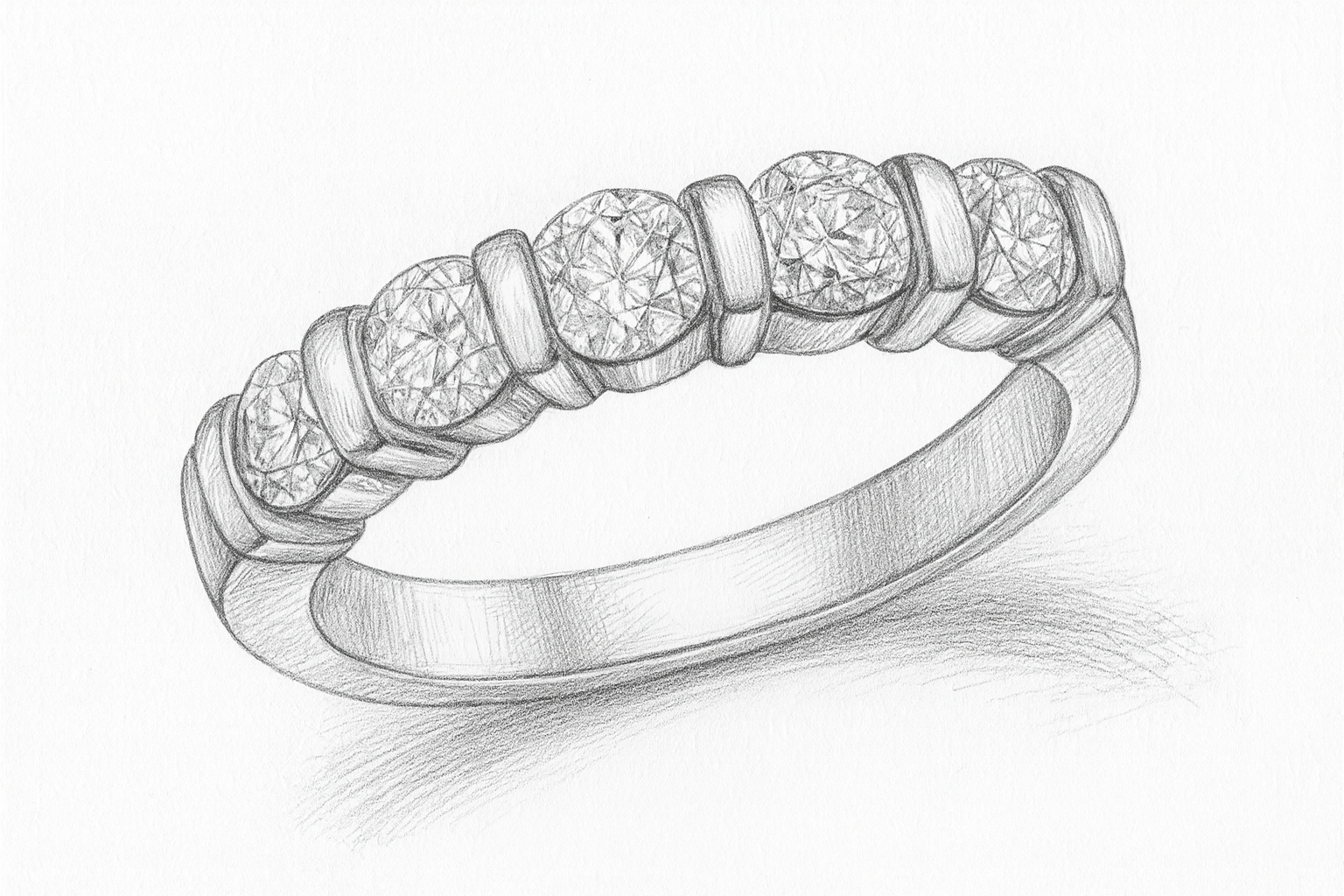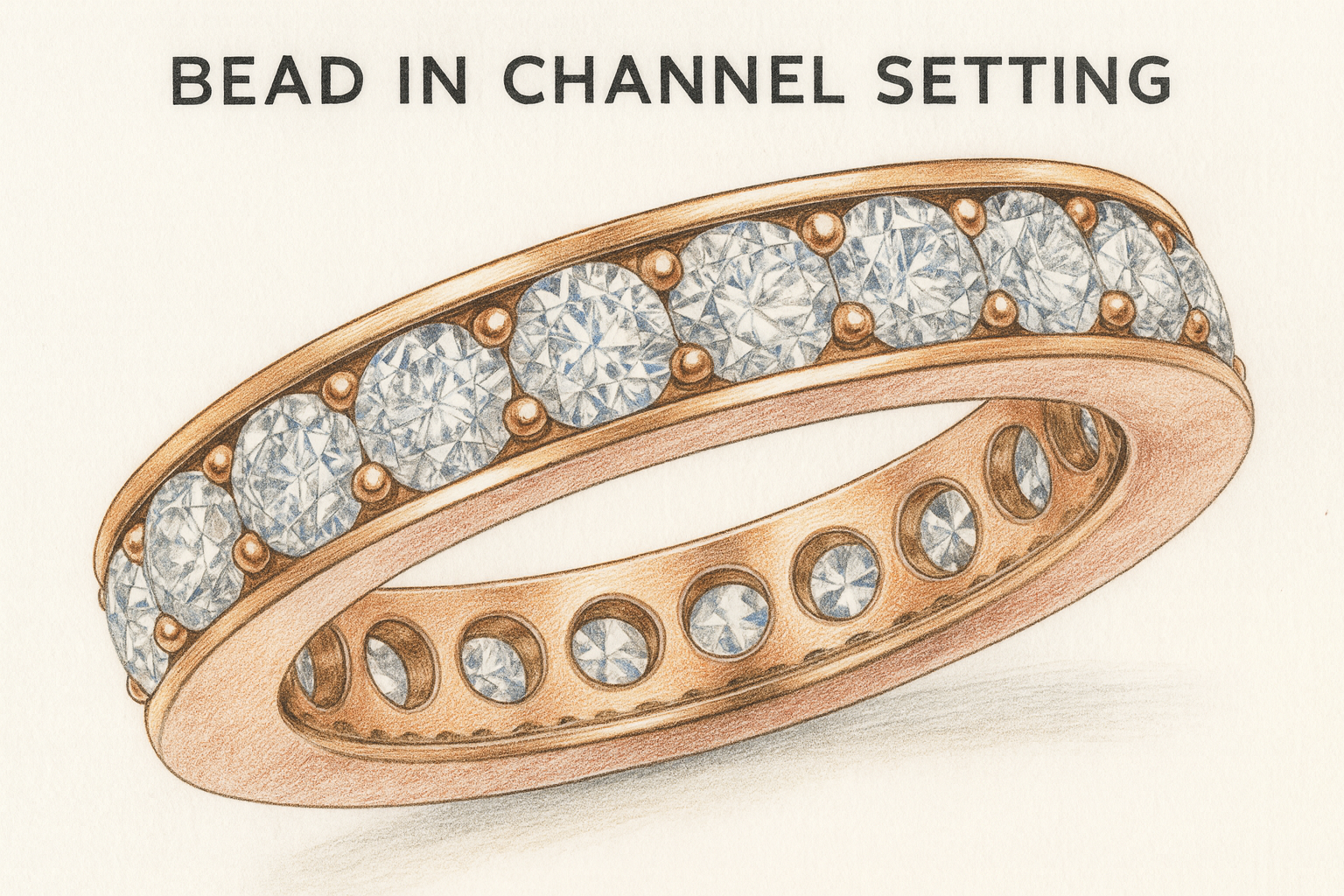Jewelry Terms Glossary
Ring Vocabulary, Terms, Terminology & Parts of a Ring
There are a variety of stone setting types. See below to learn about the different ways you can customize your ring.


Bezel Setting: A metal rim that surrounds the gemstone to secure it in place by the girdle. The bezel setting style is secure, but does not block light from entering the stone and creating brilliance.
Cathedral Setting:A cathedral setting engagement ring mimics the grace and elegance of cathedral architecture by introducing its own arches to frame the focal point of the ring – the central diamond or gemstone. The band of the ring splits, forming an upper and lower segment with the distinctive arch between them.
Center Stone: The central, dominant stone in a piece of jewelry set with multiple stones. In a ring set with one stone, the center stone is also called the solitaire.
Channel Setting: A setting style where ridges in the metal create a channel that holds gemstones securely in place.
Channel Bands: Channel settings are popular styles for wedding and anniversary bands without an elevated center gemstone. Eternity rings are channel-set bands where the stones completely encircle the ring, creating a never-ending loop of diamonds or other gems.
Claw Setting: A setting in which metal prongs, or claws, hold the gemstone in a setting. Also called prong setting. Other setting styles include bezel, channel, bar channel, and more.
Cluster Setting: A cluster setting is designed to present multiple stones – often semi-precious gems rather than diamonds – in a figural design such as a flower or butterfly. Another cluster option is to use many small stones to create the illusion of a larger gem without the expense of a single stone of higher carat weight.
Comfort fit: A special metal band design that features a rounded inside edge for more comfortable constant wear.
Engrave: To decorate by carving a design with hand tools, a stamping press, or drill. Also refers to the practice of inscribing a dedication or monogram.
Filigree: A metalworking technique that creates intricate scroll and curlicue patterns. Filigree is often used to make decorative necklace and bracelet clasps.
Finish:Used to describe the texture of polish applied to a metal. Common finishes include high polish, brushed and matte.
Flush Setting: A flush setting is made by creating a tapered hole in which the diamond sits with the surrounding metal pressed around its rim, though unlike bezels, the metal does not fold over the top of the stone.
Head: The metal basket that hold the center stone or solitaire in place.
Matte Finish: Matte is a broad category that is alternative to polished, and includes sandblasted, brushed, stone washed and more.
Millegrain Edge: A design consisting of very small, repeated ridges.
Partial Bezels: In addition to full bezels that completely surround the stone, partial bezels are becoming more popular. These trendy designs only arc across a portion of the stone, and the exact length of the bezel portions can vary according to the stone’s size, diameter, and designer’s preference.
Patina: A satin sheen that develops on the surface of platinum, produced by daily wear and tiny scratches. Many people prefer this unique look, and avoid polishing their platinum.
Pavé Setting:From the French word for pavement, these stones are set low and very close, so that the surface appears to be paved with gemstones. Pavé settings most commonly feature diamonds, but any gemstone may be used.
Peg Setting: A tiny hole is drilled halfway into the pearl and a metal bar is inserted and secured with adhesive.
Prong Setting: When a gemstone is set with prongs, each prong is bent to securely hold the gemstone by the crown. Other settings include bezel, channel, and pavé.
Ring Setting:Collective term for the shank and the head of a ring which contains no center stone.
Ring Size: A measurement, generally between 4 and 13, determined by two factors: the diameter of the finger on which the ring will be worn, and the knuckle which the ring must slip over comfortably.
Satin Finish:This satin finish is created by sandblasting with tiny glass beads. A superficial finish that, when on the outside of broad surfaces, will easily show marks. This is a great finish for recessed areas.
Semi-Mount: A setting that is complete with the exception of the center or main diamond.
Setting:Setting is the general term for the way a diamond or gemstone attached to the piece of jewelry.
Shank: The part of the ring that encircles the finger. Strictly speaking, the shank of the ring does not include the head.
Sidestone: A diamond or gemstone set alongside, or as part of a group of gemstones encircling a center stone.
Solitaire: Solitaire is the general descriptor of a single diamond or gemstone, mounted alone on the band. The setting varieties could include bezel, prong, or other styles.
Tension Setting:Rather than prongs, the entire band of the ring acts as two large prongs to hold the stone in place, usually with small carved niches that fit around the stone’s girdle. With a tensile strength of 65-95 pounds, the stone is held securely in place with a unique floating appearance.
Tiffany Settings:This classic mount is simple: four or six prongs securely hold the diamond around its girdle (the thickest portion of the stone), elevating it above a plain metal band. The prongs are spaced equally around the circumference of the stone, mimicking the symmetry of the diamond’s cut.
Three Stone Ring:A three stone ring is precisely that: a band that focuses not on a single gem, but one that highlights a row of three matched stones. Also called trilogy or trinity rings, three stone rings represent the past, present, and future of a couple’s relationship, making them particularly significant as engagement rings.
Wedding Ring:A ring which is exchanged during the wedding ceremony. It is traditionally made of precious metal and has the same width all the way around. Whether or not the wedding band matches the engagement ring is a personal preference.
Width:The width is the horizontal measurement of piece of jewelry. Any band or ring is measured across the widest area on the top. Settings are measured across the widest metal part, closest to where the center diamond is set. All measurements are approximate and refer to the widest part of the piece.
